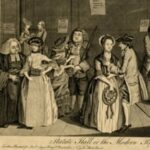Constructor Univ. Bremen; Julia Secklehner (Web)
Time: 15.-16.05.2025
Venue: Constructor Univ., Bremen
Proposals by: 15.12.2204
Central Europe’s modernist movements in the twentieth century have widely been accepted as middle-class phenomena, driven by figures with the education, time, and financial resources to devote themselves to creative production. Yet, as the First World War shook up the social and economic stability of many, comfortable backgrounds no longer guaranteed support. Women, in particular, found themselves in a new situation, not only gaining new liberties in the post-imperial successor states but often also facing the need to make a living. How did this affect their creativity and access to artistic education and production? From privately sold goods made in the home to administrative work and wage labour, women artists in the 1920s and 30s followed various professions to support themselves, their (artist) partners, and their dependents. While some of this work was to make ends meet, other activities, such as journalism and editorial work, craftwork, teaching and photography, also played an essential role in developing their artistic practice.
Taking this as a point of departure, this workshop addresses the invisible (wage) labour of modernist women artists and how it affected their creative work in different fields. It seeks to examine the ambivalences of paid and creative work faced and negotiated by individuals and their impact on our understanding of modernist artistic production. The workshop invites proposals for papers exploring examples and case studies that analyse the role of paid work in women’s artistic production. Studies can be comparative and historical analyses that take into account questions of gender, class, and race and approach the subject through, for example, art history, visual culture, labour history, or gender studies. While the main focus is on central Europe, contributions that examine examples from other geographies from the 1920s to the 1940s are welcome. Specific questions that might be addressed include, for example:
- To what extent did the necessity to follow a profession to make a living foster and develop women’s creative practice in the first half of the twentieth century?
- Which kinds of professions were particularly important in helping to develop women’s artistic practice? Which ones remained invisible?
- How did questions of class impact women artists and designers‘ opportunities and skills in relation to both wage labour and creative work? Continue reading

 EMHIS Lunch Webinar Series: Entangled Media Histories – Online Seminar
EMHIS Lunch Webinar Series: Entangled Media Histories – Online Seminar  Büro für Gleichstellung und Familie, Otto-von-Guericke-Univ. Magdeburg, Mareike Fingerhut-Säck und Bettina Hitzer
Büro für Gleichstellung und Familie, Otto-von-Guericke-Univ. Magdeburg, Mareike Fingerhut-Säck und Bettina Hitzer  The „Hidden lives: domestic servants in the European country house, c.1700-1850“-Network
The „Hidden lives: domestic servants in the European country house, c.1700-1850“-Network  Sektion Historische Pflegeforschung (HPF) und DRK Landesverband Sachsen e.V., Anja Katharina Peters
Sektion Historische Pflegeforschung (HPF) und DRK Landesverband Sachsen e.V., Anja Katharina Peters  Institut für Ungarische Geschichtsforschung in Wien; Collegium Hungaricum
Institut für Ungarische Geschichtsforschung in Wien; Collegium Hungaricum